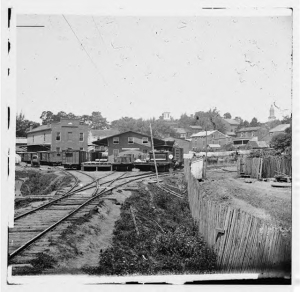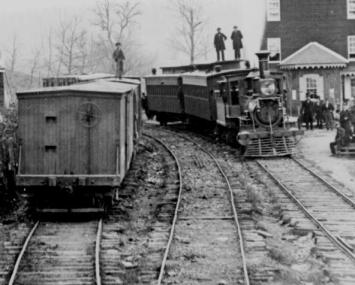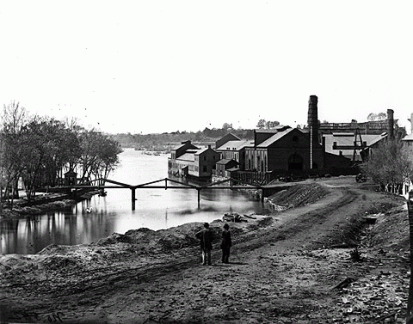Posts Tagged ‘Railroads’
Nightly News video : Railroads woven into presidential history
NBC Nightly News ran this piece tonight. My buddy Peter Hansen (above) is interviewed toward the end. His clip was filmed here in Kansas City behind the headquarters of Kansas City Southern Railway next to what is known as the Harry Truman Car. That would make his second national news program in a week or so. Not bad! See his contributions in my popular series titled Civil War Railroads here.
If the video below doesn’t play, click here or on Pete’s image above.
Vodpod videos no longer available.
Civil War Railroad Page Updated
By way of housekeeping, I’ve updated the Popular Series Posts page on the right nav bar titled Civil War Railroads here with the latest series of posts titled “Stewards of Civil War Railroads.”

Above: United States Military Railroad 4-4-0 locomotive W.H. Whiton (built by William Mason in 1862) in January 1865 with Abraham Lincoln’s presidential car, which later was used as his funeral car.
Source: Wikicommons
Stewards of Civil War Railroads – Part III
This post completes the series, Stewards of Civil War Railroads. Read Part I here and Part II here.

Above: Group of the Construction Corps U.S. Mil. R. Rds., with working tools, etc., Chattanooga, Tennessee
Courtesy of Library of Congress: LC-USZ62-62364
Millett and Maslowski posit that President Abraham Lincoln did not have Jefferson Davis’ sensitivity about government interference with railroads. The evidence supports the point and also suggests that Davis’ hands-off approach expanded to other areas under his purview including signals and communications. Whether he was afflicted with chronic indecisiveness or was bowing to the perceived whims of a public unreceptive to “big government” is open for discussion but as in many things, the truth probably lies somewhere in between. Regardless, it is clear that rational military considerations were not the sole concern in shaping the South’s military policies and programs. Had they been so, military needs would have received higher priority and the events of the war may have flowed differently.
Above: Lincoln and McClellan
The impact of the decision making processes in the Lincoln and Davis administrations and the respective Congresses as regards those issues impacting the military is indeed a fascinating one and worthy of continued analysis and review. Clearly the social, economic, and political nuances of the North versus the South had much to do with the directions taken within each section. But one is left to wonder whether the leadership qualities of Lincoln and Davis, including the ability to be decisive, allowed the North to more frequently follow a path guided by rational military reason.
Above: The engine “Firefly” on a trestle of the Orange and Alexandria Railroad.
Stewards of Civil War Railroads – Part II Davis
This post continues from Part I, here.
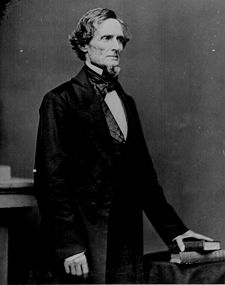
Jefferson Davis (above) and the Confederate Congress, by contrast, were reluctant to wrestle control of the railroads away from civilian owners. This was consistent with a laissez faire pattern exhibited by Davis on a number of issues involving civilian commercial interests and may have been a response to the populace’s opposition to overbearing centralized government. The consequences were dire for Lee. In the winter of 1862, he found his Army of Northern Virginia completely reliant on its communications. [i]
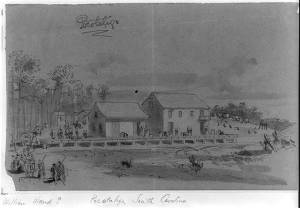
Above: Pocotaligo, South Carolina – Railroad depot center of image surrounded by rough sketch of soldiers and covered wagons. Circa: 1865
Medium: 1 drawing on tan paper : pencil, black ink wash, and Chinese white ; 14.7 x 21.4 cm. (sheet).
Source: Library of Congress Ref: LC-USZ62-14306 (b&w film copy neg.)
With the mobility, indeed the survival, of the army dependent on the efficient use of the railroads, the railroad owners responded with an assertion of their individual rights. They failed to cooperate. Government shipments were accorded low priority. The railroads over which the animals’ feed had to be transported refused to use the space for bulk fodder. The breakdown of the railroad system led to a crisis in the supply of horses, mules, fodder, and subsistence. The Army of Northern Virginia was left hanging at the end of its lines of communications.[ii]
Above: Warrenton Depot, on the Orange & Alexandria RR, in August 1862. Supply point for Lee.
Davis’ refusal to give greater control to the military for operation of the railroads added to “the weight of this burden of waging war by improvisation within the confines of the Confederacy’s social and political ideals [and] helped break the back of Confederate offensive power.” [iii]
Edward Hagerman notes that problems continued into 1863 as “conflicts between the commissary agents of field commanders and those of the [Confederate] Subsistence Department hampered efficient gathering of available resources.” [iv] The largest obstacle was “the failure of the railroads to cooperate in the distribution of food surpluses from other states to the Army of Northern Virginia. Neither the army nor the government exercised any control over the railroads.” [v] It wasn’t until Lee’s army was faced with starvation that the Confederate Congress intervened. In April of 1863, it “hesitantly” granted Jefferson Davis the “authority to regulate the railroads.” [vi]
The laissez faire-minded Davis was as reluctant to accept the authority as the Confederate Congress was to bestow it. Here was the instrument to prevent a recurrence of the crisis of the past winter. It would enable through scheduling the interchange of rolling stock from one railroad to another. It also would enable the War Department, rather than the railroad owners, to decide on the priority of material to be transported. [vii]
Davis signed the bill into law but Congress ensured its ineffectiveness by failing to approve an “office of railroad superintendent” as proposed by the secretary of war and by sacking the temporary appointee. [viii] “Not until early 1865, far too late, did the Confederacy finally take control of the railroads.” [ix]
[i, ii, iii] Edward Hagerman, The American Civil War and the Origins of Modern Warfare: Ideas, Organization, and Field Command (Bloomington: Indiana University Press, 1988), 121.
[iv, v] Ibid., 130.
[vi, vii, viii] Ibid., 131.
[ix] Allan R. Millett and Peter Maslowski, For the Common Defense: A Military History of the United States of America, 165.
Were the North and South Evenly Matched…on the Rails?
One of the questions that was much debated in class was whether the North and South were evenly matched in the American Civil War? To get the discussion rolling, our professor threw out the following…
In his interesting study of the American Civil War, Archer Jones argues in Civil War Command and Strategy: The Process of Victory and Defeat (1992), that despite its superior numbers, the Union advantage was greatly diminished by the extent of Southern territory, the intrinsic superiority of the defense over the offense, and the problems of supplying armies over long distances. Jones also states that Northern industrial dominance also proved almost useless in a war that depended less on complex weaponry and ammunition than on the man with the rifle. In Jones’ opinion, the two sides were, in fact, almost evenly matched.[i]
Our task was to take a stand on whether the North and South were evenly matched. I decided to focus on the very specific area of railroad transportation during the war. Part of my interest in this area comes from my association with friend and rail historian Peter A. Hansen, the editor of Railroad History and author of a number of articles for Trains Magazine. I was able to interview him on the topic and have included a good part of that in the post below. The photo below will be included in the upcoming issue of Railroad History which “is given over to a nearly-encyclopedic overview of every company that ever built steam locomotives in America.”[ii] The principal contributor is John H. White, Jr., former curator of transportation at the Smithsonian Institution.
Photo: New Jersey Locomotive & Machine-built 4-4-0 Fred Leach near Union Mills, Va., on August 1, 1863, the year after it was built. Its stack and tender have taken cannon shot, and the main rod is missing. It became Orange and Alexandria Warrenton after the American Civil War. Library of Congress: 111-B-185.
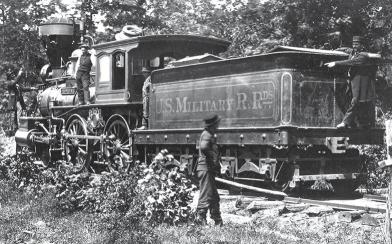
Charles Roland, in his book An American Illiad: The Story of the Civil War, provides a strong case for the American Civil War being considered the “first complete railroad war.” He asserted that the North was well ahead of the South in railroad resources entering into the war with 20,000 miles of rails in 1860 to the South’s 10,000. The railroads of the north were better “linked into systems of trunk lines that covered the entire region.”[iii] There were other things that made the North’s railroads superior. “First, it was dotted with locomotive factories, concentrated particularly in Massachusetts, Paterson, New Jersey, and Philadelphia. All of them remained beyond the reach of Rebel forces, so production was never disrupted. It was never disrupted for want of materials, either, since most of the iron ore and coal were also concentrated in the North.”[iv]
“In addition, the North’s railroads were almost all built to the standard track gauge of 4’ 8 ½”. That meant the cars could be interchanged from one line to another without the need for time-consuming unloading and reloading of passengers and freight. In the South, the rail network was pretty thin to begin with, and the multiplicity of track gauges hampered operations even more. That was particularly important considering that most of the war was fought on Southern soil. With the notable exception of one shining moment at the First Battle of Bull Run, the South was never consistently able to rush men and materiel to the front by rail. There were just too many obstacles to such smooth operation in most of Dixie.”[v]
Photo above: Station at Hanover Junction, Pa., showing an engine and cars. In November 1863 Lincoln had to change trains at this point to dedicate the Gettysburg Battlefield. LOC: 111-B- 83.
Photo below: The four-tiered, 780-foot-long railroad trestle bridge built by Federal engineers at Whiteside, Tenn., 1864. A guard camp is also shown. Photographed by George N. Barnard. LOC: 111-B-482.
“It’s a little-known fact, but track gauge was the first big standardization issue – in any industry. It seems incredible to us from our modern perspective, but many people were slow to grasp the need for standardization. It had never been needed in the days when every village had its own blacksmith or carpenter, whose products never needed to be used in conjunction with those of the smithy or carpenter in the next town.”[vi]
Photo above: Tredegar Iron Works. Artist: Alexander Gardener, Public Domain, Wikipedia Commons.
“The South didn’t have a single locomotive factory of any consequence during the Civil War. Several had made a start during the 1840s and 1850s but failed to survive into the War years – including Richmond’s famous Tredegar Iron Works (see the American Civil War Center’s site at Tredegar Iron Works here). While the firm itself survived until 1956, they produced locomotives only from 1851 to 1860. Even as the storm clouds were gathering, they decided in late 1860 that the locomotive business wasn’t profitable for them, and they retooled the shop for other uses.
“[vii]
Photo right (cropped): James Noble Sr. from www.civilwarartillery.com/manufacturers.htm.
“Aside from Tredegar, the only wartime Southern locomotive factory that’s even marginally worth mentioning was James Noble and Son of Rome, Georgia. They produced only a few locomotives after 1855 and their factory was destroyed by Sherman’s army in 1864. What this means, of course, is that Southern railroads became increasingly dysfunctional as their locomotives were destroyed, since they had no means of replacing them. It also meant that their remaining locomotives were often old, and/or held together by any means possible.”[viii]
McPherson substantiates this in his book, Battle Cry of Freedom. He indicates that of the 470 locomotives built in the U.S. in 1860; only 19 were built in the South.[ix] According to Hansen, “the production of 470 locomotives in a single year may seem like a large number. But it is less surprising in light of two things. First, railroad mileage in the U.S. had surpassed 30,000, and about 2/3 of that total had been built in the previous decade. Just like new highways today, there was comparatively little traffic on new lines in their first couple of years, but usage mushroomed when people and businesses began to change their previous transportation preferences, and when businesses began to locate along the new lines. When a line began to see more traffic, whether two or five or eight years after it was built, new locomotives were needed to handle it. An economist might say that the need for rolling stock lagged the actual construction by a few years.”[x]
“Another thing to consider is the poor utilization of assets in those days. Just as standardization was a new concept in the middle of the 19th century, so, too, was asset utilization. The latter concept is quite recent indeed, not being fully understood until just the past decade or so. [Note: Consider that Southwest Airlines ran circles around its competitors for years, chiefly because SWA insisted on having an entire fleet of identical planes, and on keeping them on the ground for only 30 minutes at each stop. The underlying rationale for both policies was better asset utilization. The older airlines are still struggling to apply those same lessons.] A steam engine is a highly labor-intensive beast. It requires constant attention from fireman and engineer alike in order to get maximum productivity while it’s working, and it spends about two hours in the shop for every hour it spends on the road. That time is absolutely necessary to the proper functioning of the machine, since grates need to be shaken, ashes need to be dumped, and moving parts need lubrication. (Tallow was a common valve lubricant in those days before petroleum engineering, and applications had to be repeated frequently.) About once a month, the steam engine’s fire was dumped altogether so the tubes and flues could be inspected. The process of cooling an engine down, inspecting it, and firing it back up typically took 24-48 hours, so there’s a big chunk of unproductive time right there. So the bottom line is that they needed a lot of locomotives in those days!”[xi]

Brilliant Uses of Railroads
The South did have some success with the use of trains for troop transfer. Johnston’s use of the Manassas Gap Railroad to move his troops to Manassas Junction to reinforce Beauregard was brilliant and no doubt influenced the outcome of that engagement which so demoralized the North. Roland also reviews Bragg’s “almost incredible strategic use of the railroads” against Buell as the latter approached Chattanooga. “The Confederates half-circled the Union army by moving 30,000 from Tupelo, Mississippi, roundabout by way of Mobile and Atlanta to Chattanooga, a movement of some 776 miles.”[xii] Hansen felt that, “while it was true that Bragg’s campaign was a remarkable success in the face of daunting logistics, this was the exception that proves the rule.” The mere fact that he had to detour 776 miles in order to go 300 speaks to the paucity of railroads in the South. And even in his 776-mile detour, he had to port his troops on foot east of Montgomery, where the railroad ended, before he could load them on trains again near Columbus, Georgia. So yes, the railroads helped him win, but I submit that it was his audacity, combined with Buell’s dithering, that gave him the ability to make the best of a questionable asset.”[xiii]
Hansen added, that “it is worth noting that railroads were the whole reason Chattanooga had such strategic significance. The principal line from Richmond to Atlanta, and the line from Memphis to the east, converged there. Without Chattanooga, the South’s ability to move men and materiel by rail in their own territory was all but gone.”[xiv]
Thomas Ziek, Jr. came to the same general conclusion in his Master’s Thesis, “The Effects of Southern Railroads on Interior Lines during the Civil War.” He tried to determine whether or not the South enjoyed the advantage of interior lines and concluded that they did not.
The use of railroads during this conflict placed an enormous physical strain upon the limited industrial resources of the Confederacy, and a great strain upon the intellectual agility of the Confederate High Command. Based upon the evidence studied, and the time-space comparisons of both Northern and Southern railway operations, several conclusions can be drawn: the South entered the war with a rail system that was unable to meet the demands of modern war; the Confederate leadership understood the importance of the railroad and its importance to strategic operations early in the war, but were unwilling to adopt a course of action that best utilized their scarce assets; Union control, maintenance, and organization of its railway assets ensured that it would be able to move large numbers of troops at the strategic level efficiently from early 1863 to the end of the war. Based on these conclusions, the Confederacy lost the ability to shift troops on the strategic level more rapidly than the Union by 1863. This was a result of its physically weakened railroad system and military setbacks which caused Southern railroads to move forces over longer distances.[xv]
My conclusion, for this area of focus, is that the North and South were NOT equally matched either in their physical rail assets nor in their management of those assets. While the South had some moments of brilliance in their use of railroads, they simply did not have the infrastructure to maintain, let alone expand, the railroads of their region to their greatest advantage.
© 2007 L. Rene Tyree
[i] White, Charles, AMU CW500.
[ii, iv, v, vi, vii, viii, x, xi, xiii, xiv] Hansen, Peter A., Personal interview. Sept. 9, 2007
[iii, xii] Roland, Charles P. An American Iliad: The Story of the Civil War
[ix] McPherson, James M. Battle Cry of Freedom
[xv] Ziek, Thomas G., Jr., “The Effects of Southern Railroads on Interior Lines During the Civil War.” A Master’s Thesis.



